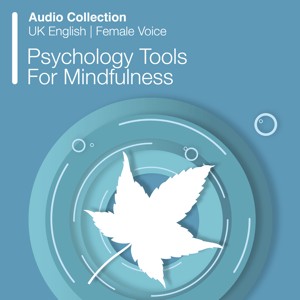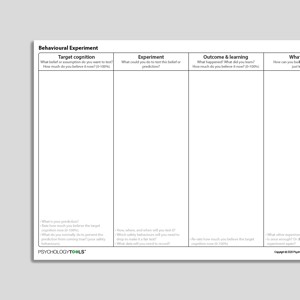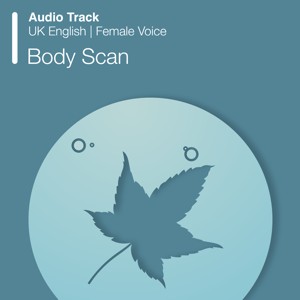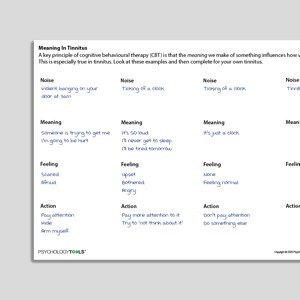Audiology And Balance
Patients who present with audiological problems frequently experience a psychological component that acts to exacerbate or maintain their condition. Specific cognitive behavioral models exist which help clinicians to understand both tinnitus and hyperacusis, and for balance disorders such as persistent postural-perceptual dizziness (PPPD). As with other physical health conditions approaches including cognitive behavioral therapy (CBT), acceptance and commitment therapy (ACT) and mindfulness have also been demonstrated to be effective (McKenna, Marks, & Vogt, 2018; Weise, Kleinstäuber, & Andersson, 2016; Westin et al., 2011).
Mindfulness In Everyday Life (Audio)
Mindfulness In Everyday Life (Audio)
Mindfulness Of Sounds And Thoughts (Audio)
Mindfulness Of Sounds And Thoughts (Audio)
Mindfulness Of Breath (Long Version) (Audio)
Mindfulness Of Breath (Long Version) (Audio)
Mindfulness Of Breath (Short Version) (Audio)
Mindfulness Of Breath (Short Version) (Audio)
Cognitive Behavioral Model Of Persistent Postural-Perceptual Dizziness (PPPD: Whalley, Cane, 2017)
Cognitive Behavioral Model Of Persistent Postural-Perceptual Dizziness (PPPD: Whalley, Cane, 2017)
Unhelpful Thinking Styles (Archived)
Unhelpful Thinking Styles (Archived)
Identifying The Meaning Of Body Sensations
Identifying The Meaning Of Body Sensations
Cognitive Behavioral Model Of Tinnitus (McKenna, Handscombe, Hoare, Hall, 2014)
Cognitive Behavioral Model Of Tinnitus (McKenna, Handscombe, Hoare, Hall, 2014)
Behavioral Experiment (Portrait Format)
Behavioral Experiment (Portrait Format)
Links to external resources
Psychology Tools makes every effort to check external links and review their content. However, we are not responsible for the quality or content of external links and cannot guarantee that these links will work all of the time.
Assessment
-
Amsterdam Misophonia Scale (A-MISO-S)
| Schröder, Vulink, Denys | 2013
- Scale
- Dizziness Handicap Inventory
- Tinnitus Reaction Questionnaire (TRQ)
- Tinnitus Handicap inventory
Guides and workbooks
- Vertigo & Dizziness | Professor Lucy Yardley | 1994
Information Handouts
- Persistent posturo-perceptual dizziness (PPPD) (Functional dizziness) | Neurosymptoms: Jon Stone | 2016
- Persistent postural perceptual dizziness (PPPD) client handout | Sarah Edelman
- Coping with a vestibular (balance) disorder | Vestibular Disorders Association | 2007
- Balance Disorders Fact Sheet | NIDCD | 2009
- Things That Go Bump In The Night – Common Causes For Tinnitus And Sound Sensitivity | Jonathan Hazell | 2003
- Tinnitus retraining therapy based on the Jastreboff Model | Hazell | 2002
Presentations
- PPPD: Early detection and integrative rehabilitation therapy improves outcomes | Jennifer Fay, Artmis Youseefnia, Tara Denham, Eva Mihovich
- Anxiety and balance | David Scott | 2016
- Testing strategies for patients with hyperacusis | Dr Gail Whitelaw
- Hearing aid and partial masking (Tinnitus) | Tyler | 2006
- Partial masking (Tinnitus) | Tyler | 2006
Recommended Reading
- Quiet Room Experiment (Experiences Of Tinnitus) | Heller, Bergman | 1953
- Schröder, A., Vulink, N., & Denys, D. (2013). Misophonia: diagnostic criteria for a new psychiatric disorder.PLoS One,8(1), e54706
- Edelstein, M., Brang, D., Rouw, R., & Ramachandran, V. S. (2013). Misophonia: physiological investigations and case descriptions.Childhood,3, 27
Persistent Postural Perceptual Dizziness
- Whalley, M. G., & Cane, D. A. (2016). A Cognitive-Behavioral Model of Persistent Postural-Perceptual Dizziness. Cognitive and Behavioral Practice
- Mahoney, A. E., Edelman, S., & Cremer, P. D. (2013). Cognitive behavior therapy for chronic subjective dizziness: longer-term gains and predictors of disability.American journal of otolaryngology,34(2), 115-120.
- Edelman, S., Mahoney, A. E., & Cremer, P. D. (2012). Cognitive behavior therapy for chronic subjective dizziness: a randomized, controlled trial.American journal of otolaryngology,33(4), 395-401.
Tinnitus
- McKenna, L,. Baguley, D., McFerran, D. J. (2010). Living with tinnitus and hyperacusis. London: Sheldon
- McKenna, L., Handscomb, L., Hoare, D. J., & Hall, D. A. (2014). A scientific cognitive-behavioral model of tinnitus: novel conceptualizations of tinnitus distress. Frontiers in neurology, 5
- Henry, J. L., Wilson, P. H. (2002). Tinnitus: A self-management guide for the ringing in your ears. Boston: Allyn & Bacon.
- Andersson, G. (2002). Psychological aspects of tinnitus and the application of cognitive-behavioural therapy. Clinical Psychology Review, 22(7), 977-990.
What Are Audiological Problems?
Signs and Symptoms of Tinnitus and Hyperacusis
Tinnitus is the name for hearing a sound in the absence of an outside source. Tinnitus can sound like ringing, buzzing, whooshing, humming, hissing, throbbing, or can be musical. Noises may be heard in one ear or both, or in the middle of the head. Some people initially perceive that the noise is coming from an outside source and hunt for it until they realize that it is in their head. The noise may be constant or intermittent.Hyperacusis is the name given to a condition where people experience the sounds of everyday life as being intrusively loud, uncomfortable, and even painful. Some people respond to hyperacusis by withdrawing from activities or by using earplugs or headphones to block out noise.Signs and Symptoms of PPPD
PPPD has also been known as phobic postural vertigo (PPV) and chronic subjective dizziness (CSD). PPPD is characterized by three main symptom clusters:persistent non-rotatory dizziness that lasts three or more months;
hypersensitivity to motion stimuli (including the patient’s own movement) and hypersensitivity to visual stimuli including the movement of objects in a busy visual environment;
difficulty with precision visual tasks such as reading or using computers.
Signs and Symptoms of Misophonia
Misophonia, also known as selective sound sensitivity, is characterized by a strong emotional response to certain types of sounds. Sounds that trigger a misophonia response are almost always human-generated noises which are under voluntary control—examples include sniffing, throat-clearing, or chewing. The most common emotional response to these noises in misophoniaare anger, disgust, and anxiety.Psychological Models and Theory of Tinnitus and Hyperacusis
Most people with chronic tinnitus have some degree of hearing loss (Ratnayake, Jayarajan, & Bartlett, 2009), although only a minority of people with hearing loss experience tinnitus. It is believed that changes in central auditory pathways are at least partly responsible for the experience of tinnitus. A number of cognitive behavioral models of tinnitus have been proposed that weave together physiological and psychological components:McKenna, Handscomb, Hoare, and Hall’s (2014) cognitive behavioral model of tinnitus proposes that individuals with tinnitus may form appraisals about the harmfulness and uncontrollability of their tinnitus. Regardless of the cause of the tinnitus, once it has been detected and appraisals formed, attention toward the tinnitus and emotional reactions elicit behavioral reactions which lead to short-term relief but long-term maintenance.
Fear-avoidance models of tinnitus (Cima, Crombez, & Vlaeyen, 2011; Kleinstäuber et al., 2013) stress the importance of fear reactions and safety behaviors in the maintenance of chronic tinnitus. Negative emotional reactivity, misinterpretations of tinnitus as threatening, and self-defeating fear responses such as avoidance and escape are seen as self-reinforcing and prolong impairment.
Psychological Models and Theory of PPPD
Whalley and Cane (2017) proposed a cognitive behavioral model of PPPD. In common with models of panic, pain, and health anxiety, the model includes the transdiagnostic mechanism of interoceptive avoidance (Barlow, 2004) where the anxious avoidance of somatic sensation leads to a feedback cycle in which the individual fails to learn about its ultimately benign nature.Psychological Models and Theory of Misophonia
In an open trial Schröder, Vulink, van Loon, and Denys (2017) reported that cognitive behavioral therapy (CBT) was effective in the treatment of misophonia. They theorize that attention to misophonic triggers could be due to impaired attentional control, and the automatic negative reactions could be due to increased irritability levels. Their intervention consisted of task concentration exercises, counterconditioning, stress manipulation, and relaxation exercises.Evidence-Based Psychological Approaches for Working with Tinnitus and Hyperacusis
Cognitive behavioral therapy (CBT) including ‘third wave’ elements of mindfulness and acceptance currently appear to be the most strongly indicated psychological approach to the treatment of tinnitus (Cima, Andersson, Schmidt, & Henry, 2014; Hesser, Weise, Westin, & Andersson, 2011).Evidence-Based Psychological Approaches for Working with PPPD
A range (and perhaps combination) of techniques appear to be helpful in the treatment of PPPD. These include vestibular rehabilitation, cognitive behavioral therapy, and mindfulness approaches (e.g., Trinidade & Goebel, 2018).Evidence-Based Psychological Approaches for Working with Misophonia
Schröder et al. (2017) reported encouraging results from a trial of CBT for misophonia in which the interventions included: task concentration exercises, counterconditioning, stress manipulation, and relaxation exercises.Resources for Working with Audiological Conditions Including Tinnitus, Hyperacusis, PPPD, and Misophonia
Psychology Tools resources available for working therapeutically with tinnitus, hyperacusis, PPPD and misophonia may include:psychological models of tinnitus, hyperacusis, PPPD, and misophonia
information handouts for psychoeducation
exercises for intervention
CBT worksheets for intervention
self-help programs
References
Barlow, D. H. (2004). Anxiety and its disorders: The nature and treatment of anxiety and panic. New York: Guilford Press.
Cima, R. F., Andersson, G., Schmidt, C. J., & Henry, J. A. (2014). Cognitive-behavioral treatments for tinnitus: A review of the literature. Journal of the American Academy of Audiology,25(1), 29–61.
Cima, R. F., Crombez, G., & Vlaeyen, J. W. (2011). Catastrophizing and fear of tinnitus predict quality of life in patients with chronic tinnitus. Ear and Hearing, 32(5), 634–641.
Hesser, H., Weise, C., Westin, V. Z., & Andersson, G. (2011). A systematic review and meta-analysis of randomized controlled trials of cognitive–behavioral therapy for tinnitus distress. Clinical Psychology Review, 31(4), 545–553.
Kleinstäuber, M., Jasper, K., Schweda, I., Hiller, W., Andersson, G., & Weise, C. (2013). The role of fear-avoidance cognitions and behaviors in patients with chronic tinnitus. Cognitive Behaviour Therapy, 42(2), 84–99.
McKenna, L., Handscomb, L., Hoare, D. J., & Hall, D. A. (2014). A scientific cognitive-behavioral model of tinnitus: Novel conceptualizations of tinnitus distress. Frontiers in Neurology, 5, 196.https://doi.org/10.3389/fneur.2014.00196
McKenna, L., Marks, E. M., & Vogt, F. (2018). Mindfulness-based cognitive therapy for chronic tinnitus: Evaluation of benefits in a large sample of patients attending a tinnitus clinic. Ear and Hearing, 39(2), 359–366.
Ratnayake, S. A. B., Jayarajan, V., & Bartlett, J. (2009). Could an underlying hearing loss be a significant factor in the handicap caused by tinnitus? Noise and Health, 11(44), 156–160.
Schröder, A. E., Vulink, N. C., van Loon, A. J., & Denys, D. A. (2017). Cognitive behavioral therapy is effective in misophonia: An open trial. Journal of Affective Disorders, 217, 289–294.
Trinidade, A., & Goebel, J. A. (2018). Persistent postural-perceptual dizziness: A systematic review of the literature for the balance specialist. Otology & Neurotology, 39(10), 1291–1303.
Weise, C., Kleinstäuber, M., & Andersson, G. (2016). Internet-delivered cognitive-behavior therapy for tinnitus: A randomized controlled trial. Psychosomatic Medicine, 78(4), 501–510.
Westin, V. Z., Schulin, M., Hesser, H., Karlsson, M., Noe, R. Z., Olofsson, U., … & Andersson, G. (2011). Acceptance and commitment therapy versus tinnitus retraining therapy in the treatment of tinnitus: A randomisedcontrolled trial. Behaviour Research and Therapy, 49(11), 737–747.
Whalley, M. G., & Cane, D. A. (2017). A cognitive-behavioral model of persistent postural-perceptual dizziness. Cognitive and Behavioral Practice, 24(1), 72–89.





















